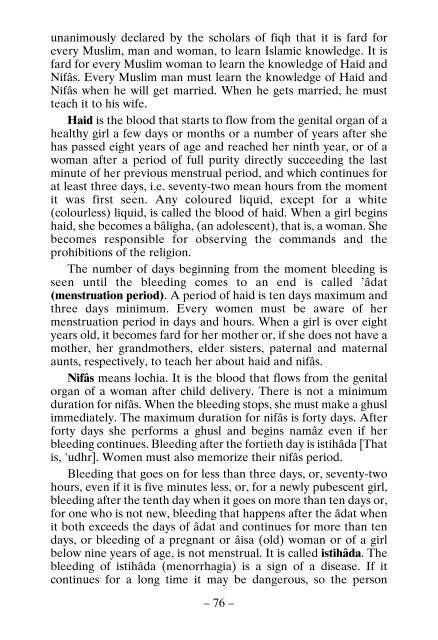Book of Namaz
Create successful ePaper yourself
Turn your PDF publications into a flip-book with our unique Google optimized e-Paper software.
unanimously declared by the scholars <strong>of</strong> fiqh that it is fard for<br />
every Muslim, man and woman, to learn Islamic knowledge. It is<br />
fard for every Muslim woman to learn the knowledge <strong>of</strong> Haid and<br />
Nifâs. Every Muslim man must learn the knowledge <strong>of</strong> Haid and<br />
Nifâs when he will get married. When he gets married, he must<br />
teach it to his wife.<br />
Haid is the blood that starts to flow from the genital organ <strong>of</strong> a<br />
healthy girl a few days or months or a number <strong>of</strong> years after she<br />
has passed eight years <strong>of</strong> age and reached her ninth year, or <strong>of</strong> a<br />
woman after a period <strong>of</strong> full purity directly succeeding the last<br />
minute <strong>of</strong> her previous menstrual period, and which continues for<br />
at least three days, i.e. seventy-two mean hours from the moment<br />
it was first seen. Any coloured liquid, except for a white<br />
(colourless) liquid, is called the blood <strong>of</strong> haid. When a girl begins<br />
haid, she becomes a bâligha, (an adolescent), that is, a woman. She<br />
becomes responsible for observing the commands and the<br />
prohibitions <strong>of</strong> the religion.<br />
The number <strong>of</strong> days beginning from the moment bleeding is<br />
seen until the bleeding comes to an end is called ’âdat<br />
(menstruation period). A period <strong>of</strong> haid is ten days maximum and<br />
three days minimum. Every women must be aware <strong>of</strong> her<br />
menstruation period in days and hours. When a girl is over eight<br />
years old, it becomes fard for her mother or, if she does not have a<br />
mother, her grandmothers, elder sisters, paternal and maternal<br />
aunts, respectively, to teach her about haid and nifâs.<br />
Nifâs means lochia. It is the blood that flows from the genital<br />
organ <strong>of</strong> a woman after child delivery. There is not a minimum<br />
duration for nifâs. When the bleeding stops, she must make a ghusl<br />
immediately. The maximum duration for nifâs is forty days. After<br />
forty days she performs a ghusl and begins namâz even if her<br />
bleeding continues. Bleeding after the fortieth day is istihâda [That<br />
is, 'udhr]. Women must also memorize their nifâs period.<br />
Bleeding that goes on for less than three days, or, seventy-two<br />
hours, even if it is five minutes less, or, for a newly pubescent girl,<br />
bleeding after the tenth day when it goes on more than ten days or,<br />
for one who is not new, bleeding that happens after the âdat when<br />
it both exceeds the days <strong>of</strong> âdat and continues for more than ten<br />
days, or bleeding <strong>of</strong> a pregnant or âisa (old) woman or <strong>of</strong> a girl<br />
below nine years <strong>of</strong> age, is not menstrual. It is called istihâda. The<br />
bleeding <strong>of</strong> istihâda (menorrhagia) is a sign <strong>of</strong> a disease. If it<br />
continues for a long time it may be dangerous, so the person<br />
– 76 –

















